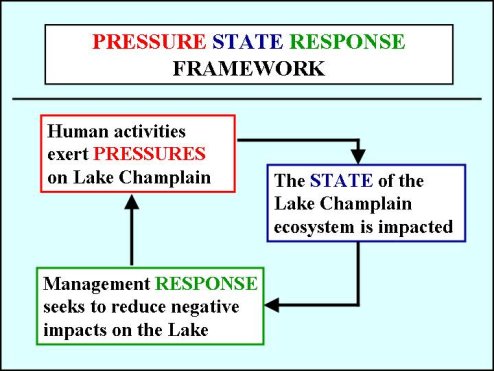|
Our week aptly began at one of Burlington’s most beloved and important sites, Lake Champlain. Over 200,000 people use the lake for drinking water; it is also an important source of recreation, as well as recreational and commercial fisheries, such as salmon, trout and perch. It is also home to what many consider to be the best underwater preserves of shipwrecks in North America.
The class began the day at the Rubenstein Ecosystem Science Laboratory. Our first speaker, Lisa Windhausen, Aquatic Nuisance Species Coordinator from the Lake Champlain Basin Program, illuminated some of the issues facing the watershed. Three of the major issues that Lisa focused on are:
- Algal blooms – In the south lake, St. Alban’s Bay, and Missiqoui Bay, non-point and point sources of pollution rob the water of oxygen, which then leads to the overgrowth of algae, creating blooms that are responsible for fish kills.
- Shoreline erosion – Bank erosion of many of the lake's tributaries releases sediments and pollution that are carried into the lake ecosystem. There are several stream bank restoration projects that are addressing this issue.
- Non-native aquatic species – Over 40 species of non-native invasive plants and animals have entered the Lake Champlain Basin. They degrade fish habitats, reduce fish egg and fry survival, alter water clarity and chemistry, and threaten biodiversity. Some questions were raised to determine if all species were considered ‘destructive’, and what role the public can play in ameliorating the problem.
An overarching question that emerged is how to effectively communicate these pressing issues to the public? The challenge is not only how to disseminate this information to the public, but how to do it in such a way that the public becomes engaged and takes an active role in alleviating these issues. There are several citizen stewardship projects being conducted presently, and the program continuously looks for channels to increase public outreach and participation. Indeed, this theme, of the intersection of science and public understanding, arose throughout the day and week.
We next visited the ECHO Leahy Center for Lake Champlain. ECHO is a museum/aquarium/learning center located right on Lake Champlain that focuses on the ecology of the Champlain basin. We spoke with director Phelan Fretz about the goals of the center and how the center is managed. Many school groups and tours visit the center, and Phelan thought this was precisely the point of ECHO, to make available to the public the knowledge of what is occurring in the Champlain basin. ECHO seemed to be part of the answer to the question: “How do we communicate the importance of science to the public?”
Our third speaker of the day was Mary Watzin, director of UVM's Rubenstein Ecosystem Science Laboratory. Mary described the lake as a young one with great biodiversity, but one with many problems as well. Perhaps most notably, the addition of phosphorous into the lake from non-point sources (agriculture, urban and suburban areas) is causing eutrophication. Researchers are asking “what role does this have on algal blooms, and what relevance does this have to other species in the lake?” Mary pointed out that questions based on natural science aren’t the only ones that need to be asked. The bulk of the remaining projects at the laboratory are looking at nuisance species, namely zebra-mussels, sea lamprey, and cormorants. After outlining the science occurring at the lab, we spoke about how this relates to the public.
 |
| http://www.uvm.edu/envnr/indicators/index.html |
By the end of our discussion, it was clear that the lake has its problems, but hopefully with research and public efforts, some of the impacts can be lessened.
Just before lunch, Crea Lintilhac spoke with us about the Lintilhac Foundation and their support of projects that investigate
and work to improve the health of Lake Champlain. While she noted the
importance of sound science, she also stressed that without advocacy and
community alliances, regulation and policy would not be pushed through, and
development practices that are not environmentally sound would be allowed to
continue unchecked.

 Mt. Mansfield
Mt. Mansfield









